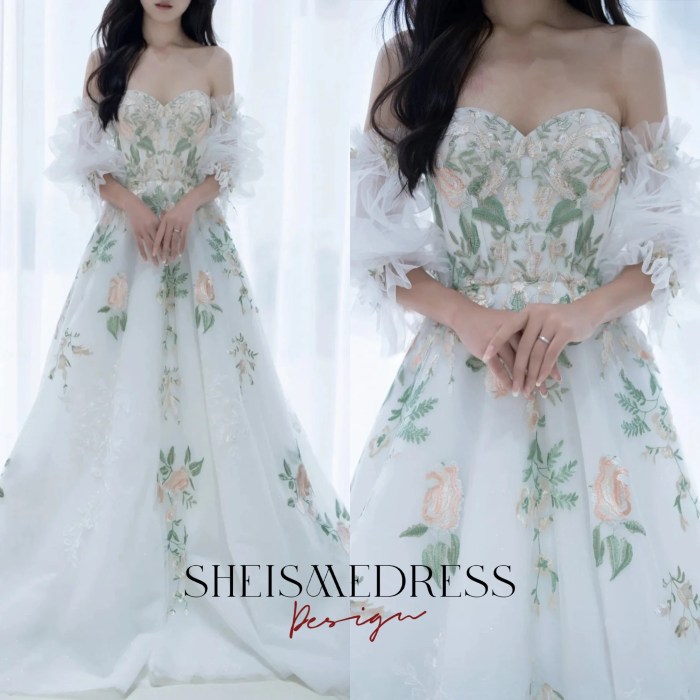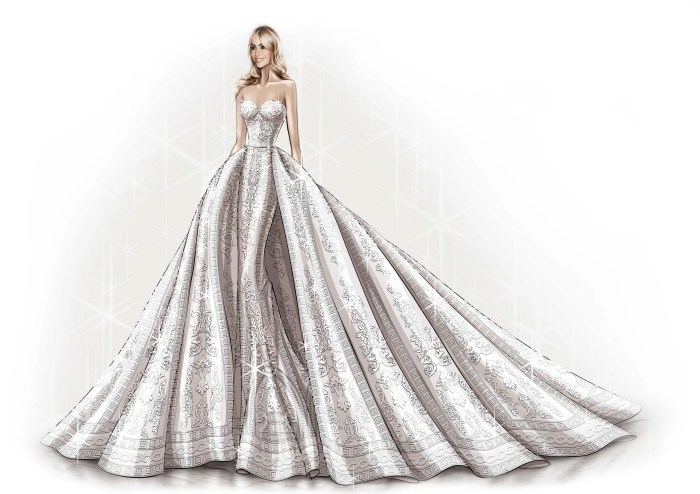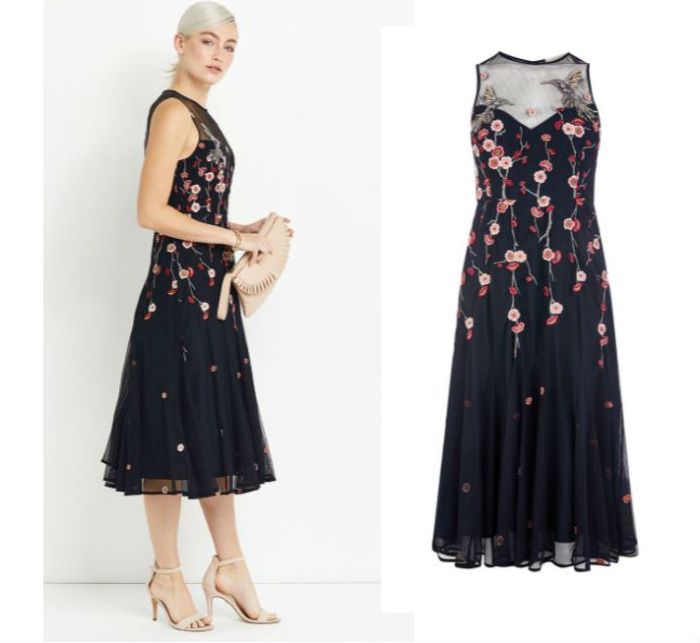Formal Floral Dresses for Weddings
Formal floral dresses for weddings – Choosing the perfect dress for a wedding can be a delightful yet challenging experience. Formal floral dresses offer a beautiful balance of elegance and playfulness, making them a popular choice for wedding guests. This guide explores various aspects of selecting and styling a formal floral dress, ensuring you make a stylish and appropriate statement at any wedding.
Dress Styles & Fabrics
Several dress styles and fabrics lend themselves well to the creation of a stunning formal floral wedding dress. The choice often depends on personal preference, body type, and the wedding’s formality.
- A-line Midi Dress: This universally flattering silhouette is suitable for most body types and wedding settings. The A-line shape skims the body gracefully, and a midi length offers a balance of formality and comfort. Floral prints in delicate patterns like scattered blooms or small-scale florals work well.
- Fit-and-Flare Maxi Dress: This style emphasizes the waist and flows elegantly to the floor. It’s ideal for formal evening weddings or black-tie events. Richer fabrics like silk or crepe, paired with bold floral prints or a more structured design, enhance its sophistication.
- Sheath Dress: A sheath dress offers a sleek, sophisticated look, ideal for modern or minimalist weddings. Its close-fitting silhouette showcases the figure. Choose a high-quality fabric like crepe or silk, and opt for a more graphic or abstract floral pattern to maintain a refined appearance.
- Wrap Dress: The versatile wrap dress flatters various body types and offers a touch of femininity. It’s appropriate for less formal weddings or daytime celebrations. Lightweight fabrics like chiffon or cotton blends, paired with vibrant floral prints, create a charming and elegant look.
- High-Neck Gown: For a more formal and elegant look, a high-neck gown provides a classic and sophisticated style. This style works beautifully with luxurious fabrics like silk or velvet and can feature a variety of floral prints, from delicate botanical designs to more dramatic, oversized blooms.
Fabric choice significantly impacts the overall look and feel. Silk offers a luxurious drape and sheen, perfect for evening weddings. Chiffon is lightweight and airy, ideal for warmer months. Lace adds a touch of romance and texture, while crepe provides structure and a sophisticated finish. Consider the season and the wedding’s formality when selecting your fabric.
Elegant floral patterns for formal weddings range from delicate watercolor prints to more graphic designs featuring bold blooms. Think intricate botanical illustrations, Art Nouveau-inspired motifs, or subtle floral embroidery on a solid background. Avoid overly childish or cartoonish prints for a formal setting.
Color Palettes & Trends
Color plays a crucial role in determining the overall aesthetic of a formal floral dress. The right palette can complement your complexion and the wedding’s theme.
| Palette Name | Dominant Color | Accent Colors | Suggested Floral Pattern |
|---|---|---|---|
| Romantic Blush | Blush Pink | Rose Gold, Ivory | Delicate watercolor roses and peonies |
| Moody Jewel Tones | Deep Emerald Green | Burgundy, Sapphire Blue | Dark, rich florals like anemones and dahlias |
| Classic Navy & White | Navy Blue | White, Cream | Simple, elegant white floral sprigs on a navy background |
| Summer Citrus Burst | Sunshine Yellow | Coral, Tangerine | Vibrant, tropical-inspired blooms |
| Earthy Botanicals | Dusty Rose | Olive Green, Taupe | Subtle, muted florals with foliage accents |
Current trends lean towards rich jewel tones, bold floral prints, and sophisticated color combinations. In the coming year, we can anticipate a continued popularity of muted earth tones and unique, abstract floral patterns. The resurgence of vintage-inspired styles might also lead to a rise in dresses featuring delicate, antique-looking floral prints.
Color palettes can effectively complement different wedding themes. A rustic wedding might call for earthy tones and muted florals, while a modern wedding could feature a sleek, monochromatic palette with a graphic floral print. A classic wedding might be best suited to a timeless color combination like navy and white with elegant floral details.
Accessorizing & Styling
Accessories and hairstyles are essential in completing a polished and cohesive look with a formal floral dress. The right choices can elevate the overall style and complement the dress’s design.
- Look 1: Elegant & Classic: A fit-and-flare maxi dress in a deep jewel-toned floral print paired with delicate gold jewelry (delicate necklace and earrings), nude heels, and a small clutch. A sleek, low chignon hairstyle complements the elegance of the dress.
- Look 2: Romantic & Feminine: A flowy A-line midi dress in a soft pastel floral print paired with pearl jewelry, delicate ankle strap heels, and a straw clutch. Loose, romantic waves or a half-up half-down hairstyle enhance the overall romantic feel.
- Look 3: Modern & Chic: A sheath dress in a bold, graphic floral print paired with statement earrings, pointed-toe heels, and a structured handbag. A high ponytail or a chic top knot complements the modern aesthetic.
Consider the venue and dress style when accessorizing. A formal evening wedding might call for more elaborate jewelry and heels, while a daytime wedding could allow for more casual accessories. Ensure that the accessories complement the dress’s colors and patterns without overwhelming the overall look.
Hairstyles should also complement the dress and the overall look. A sleek updo works well with a structured dress, while loose waves or braids suit a more flowing style. Consider hair length and texture when choosing a hairstyle; a voluminous hairstyle might be ideal for those with fine hair, while a sleek updo is suitable for thick hair.
Price Ranges & Shopping
The price of a formal floral wedding dress varies significantly depending on several factors. Understanding these factors can help you make an informed decision and find a dress within your budget.
Price ranges can span from a few hundred dollars for dresses from fast-fashion retailers to several thousand dollars for designer gowns. Fabric quality, embellishments (like beading or embroidery), and designer brand significantly influence the cost. Dresses made from luxurious fabrics like silk or those featuring intricate detailing will typically be more expensive.
- Strategy 1: Budget-Friendly Shopping: Explore online retailers and department stores known for affordable options. Look for sales and discounts. This strategy offers a wide selection but may require more time spent searching.
- Strategy 2: Consignment or Resale: Consider purchasing a pre-owned dress from a consignment shop or online resale platform. This can offer significant savings, but selection might be limited.
- Strategy 3: Mix-and-Match: Purchase a simpler dress and elevate it with luxurious accessories. This allows for more budget flexibility and personalization.
Factors influencing price include fabric quality (silk is more expensive than polyester), craftsmanship (hand-beading increases cost), and designer brand recognition (established designers command higher prices).
Ethical & Sustainable Considerations, Formal floral dresses for weddings
Increasingly, consumers are prioritizing ethical and sustainable choices when making purchases. The wedding dress industry is no exception. Consider the environmental and social impact of your purchase.
Look for brands that use sustainably sourced fabrics (like organic cotton or recycled materials), employ fair labor practices, and minimize waste in their production processes. Transparency in supply chains is also crucial. Research brands known for their commitment to ethical and sustainable practices before making a purchase.
Formal floral dresses offer a charming alternative for wedding attire, balancing elegance with a touch of whimsy. For those opting for a more intimate ceremony, the style translates beautifully to courthouse weddings; consider checking out these courthouse wedding dress ideas for inspiration. Ultimately, a well-chosen floral dress, regardless of venue, ensures a memorable and stylish celebration.
To identify an ethically and sustainably produced dress, look for certifications (like GOTS for organic cotton), read brand mission statements and sourcing information, and consider supporting smaller brands with transparent practices. Choosing a dress made from durable, high-quality materials that will last longer also contributes to sustainability.
FAQ Guide: Formal Floral Dresses For Weddings
Can I wear a floral dress to a black-tie wedding?
While generally black-tie weddings lean towards more formal, solid-color gowns, a sophisticated floral print in rich, dark colors (e.g., navy, emerald green) with luxurious fabric like silk or velvet
-could* be acceptable. However, err on the side of caution and check the invitation for dress code specifics.
How do I care for a floral dress after the wedding?
Care instructions vary depending on the fabric. Always check the care label. Generally, delicate fabrics like silk and chiffon should be dry-cleaned, while sturdier fabrics like crepe may be hand-washed or machine-washed on a gentle cycle. Proper storage, such as using garment bags, helps preserve the dress’s condition.
What if the floral print is too bold for a formal setting?
Subtle, smaller-scale floral prints in muted tones generally work best for formal settings. If your dress features a larger or more vibrant print, consider balancing it with more subdued accessories and a simpler hairstyle.
Are there any specific etiquette rules for floral dresses at weddings?
Avoid overly bright or casual prints. Choose a dress that is appropriate for the wedding’s formality level and venue. Always ensure your dress is clean, well-fitting, and not too revealing.



